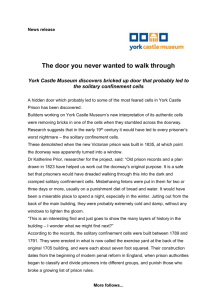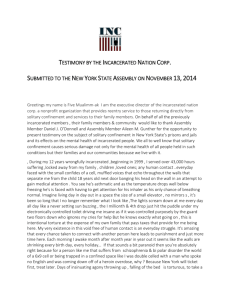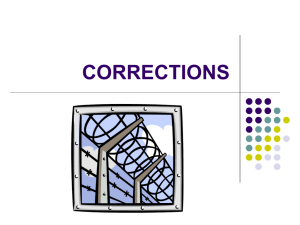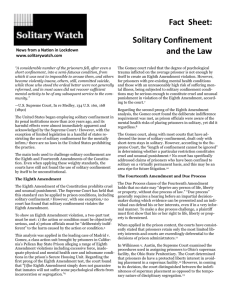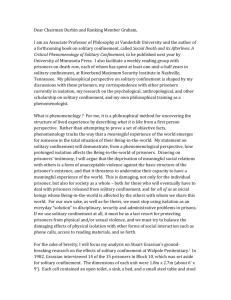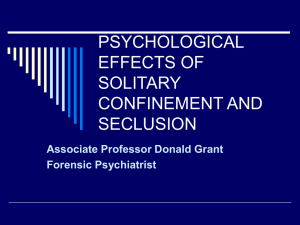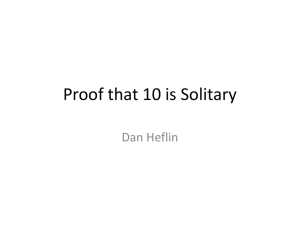Fact Sheet: Psychological Effects of Solitary
advertisement
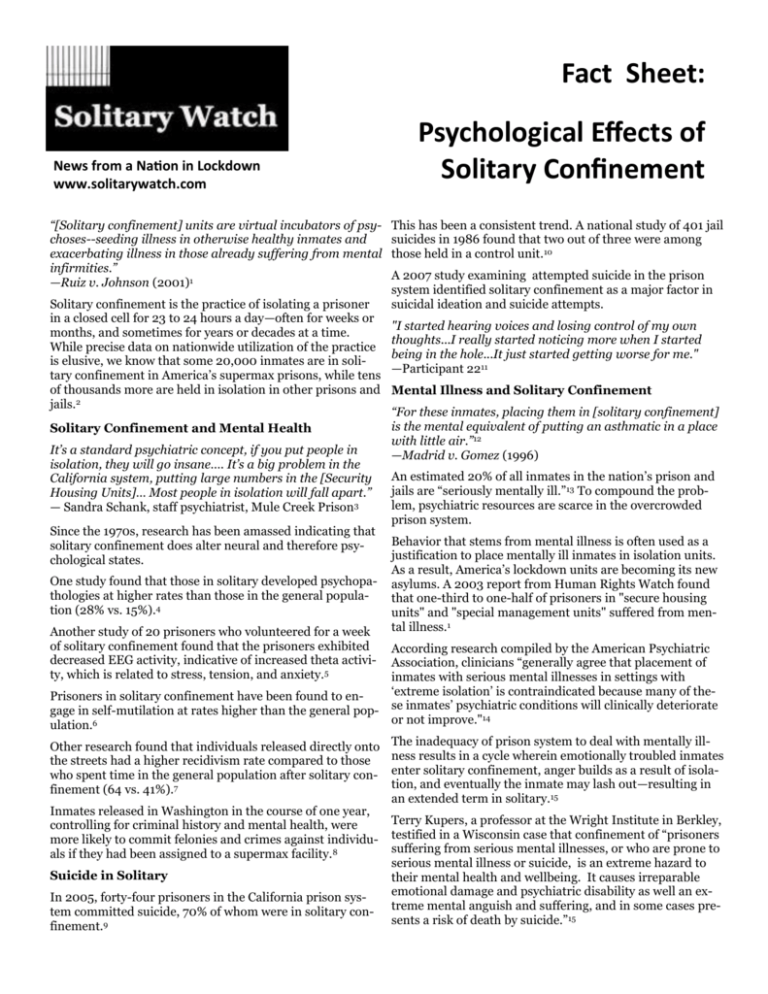
Fact Sheet: News from a Nation in Lockdown www.solitarywatch.com “[Solitary confinement] units are virtual incubators of psychoses--seeding illness in otherwise healthy inmates and exacerbating illness in those already suffering from mental infirmities.” —Ruiz v. Johnson (2001)1 Solitary confinement is the practice of isolating a prisoner in a closed cell for 23 to 24 hours a day—often for weeks or months, and sometimes for years or decades at a time. While precise data on nationwide utilization of the practice is elusive, we know that some 20,000 inmates are in solitary confinement in America‘s supermax prisons, while tens of thousands more are held in isolation in other prisons and jails.2 Solitary Confinement and Mental Health It’s a standard psychiatric concept, if you put people in isolation, they will go insane…. It’s a big problem in the California system, putting large numbers in the [Security Housing Units]… Most people in isolation will fall apart.” — Sandra Schank, staff psychiatrist, Mule Creek Prison3 Since the 1970s, research has been amassed indicating that solitary confinement does alter neural and therefore psychological states. One study found that those in solitary developed psychopathologies at higher rates than those in the general population (28% vs. 15%).4 Another study of 20 prisoners who volunteered for a week of solitary confinement found that the prisoners exhibited decreased EEG activity, indicative of increased theta activity, which is related to stress, tension, and anxiety.5 Psychological Effects of Solitary Confinement This has been a consistent trend. A national study of 401 jail suicides in 1986 found that two out of three were among those held in a control unit.10 A 2007 study examining attempted suicide in the prison system identified solitary confinement as a major factor in suicidal ideation and suicide attempts. "I started hearing voices and losing control of my own thoughts...I really started noticing more when I started being in the hole...It just started getting worse for me." —Participant 2211 Mental Illness and Solitary Confinement “For these inmates, placing them in [solitary confinement] is the mental equivalent of putting an asthmatic in a place with little air.”12 —Madrid v. Gomez (1996) An estimated 20% of all inmates in the nation‘s prison and jails are ―seriously mentally ill.‖13 To compound the problem, psychiatric resources are scarce in the overcrowded prison system. Behavior that stems from mental illness is often used as a justification to place mentally ill inmates in isolation units. As a result, America‘s lockdown units are becoming its new asylums. A 2003 report from Human Rights Watch found that one-third to one-half of prisoners in "secure housing units" and "special management units" suffered from mental illness.1 According research compiled by the American Psychiatric Association, clinicians ―generally agree that placement of inmates with serious mental illnesses in settings with ‗extreme isolation‘ is contraindicated because many of thePrisoners in solitary confinement have been found to enconditions will clinically deteriorate gage in self-mutilation at rates higher than the general pop- se inmates‘ psychiatric 14 or not improve." 6 ulation. Other research found that individuals released directly onto the streets had a higher recidivism rate compared to those who spent time in the general population after solitary confinement (64 vs. 41%).7 Inmates released in Washington in the course of one year, controlling for criminal history and mental health, were more likely to commit felonies and crimes against individuals if they had been assigned to a supermax facility. 8 Suicide in Solitary In 2005, forty-four prisoners in the California prison system committed suicide, 70% of whom were in solitary confinement.9 The inadequacy of prison system to deal with mentally illness results in a cycle wherein emotionally troubled inmates enter solitary confinement, anger builds as a result of isolation, and eventually the inmate may lash out—resulting in an extended term in solitary.15 Terry Kupers, a professor at the Wright Institute in Berkley, testified in a Wisconsin case that confinement of ―prisoners suffering from serious mental illnesses, or who are prone to serious mental illness or suicide, is an extreme hazard to their mental health and wellbeing. It causes irreparable emotional damage and psychiatric disability as well an extreme mental anguish and suffering, and in some cases presents a risk of death by suicide.‖15 Pelican Bay State Prison Pelican Bay State Prison is a supermax prison in Del Norte California. In 1993, the prison was subject of a suit filed on behalf of 3,600 prisoners alleging violations of rights and abuse.3 Dr. Stuart Grassian submitted testimony resulting from his extensive interviews with PBSP prisoners, suggesting that solitary confinement induces a specific psychiatric disorder characterized by: hypersensitivity to external stimuli, hallucinations, panic attacks, cognitive deficits, obsessive thinking, paranoia, and impulse control problems.17 Psychological assessments of Pelican Bay‘s solitary confined prisoners indicate high rates of anxiety, nervousness, obsessive ruminations, anger, violent fantasies, nightmares, trouble sleeping, as well as dizziness, perspiring hands, and heart palpitations.18 Future Directions In some states, lawsuits brought by prisoners and their advocates have resulted in limits on the incarceration of mentally ill patients in solitary confinement. 19 Even in states with outright bans, problems remain with the diagnosis of inmates‘ mental illnesses and the creation of humane alternatives to solitary confinement. © by Todd (Hyung-Rae) Tarselli. who spent 9 years in solitary confinement at Pennsylvania‘s SCI Greene. violence inside facilities and contributing to recidivism For prisoners without underlying mental illness, the after release.‖ courts have largely ignored or condoned the use of solitary The Commission recommended that prison administraconfinement, despite evidence of psychological harm. tors: In 2006, the Commission on Safety and Abuse in Ameri―1. Make segregation a last resort and a more productive ca's Prisons, following a yearlong investigation, called for form of confinement, and stop releasing people directly dramatic reductions and reforms on the practice of solifrom segregation to the streets... tary confinement, noting the high recidivism rate and the 2. End conditions of isolation: Ensure that segregated viability of alternatives to solitary confinement. prisoners have regular and meaningful human contact... The Commission found that the ―increasing use of high3. Protect mentally ill prisoners...‖7 security segregation is counter-productive, often causing 1. Human Rights Watch (2003), Ill-Equipped: U.S. Prisons and Offenders with Mental Illness 149 n. 513 (New York: Human Rights Watch. 2. Naday, A., Freilich, J. & Mellow, Jeff. (2008), ―The Elusive Data on Supermax Confinement, ―The Prison Journal 88, 69. 3. Ruiz v Johnson, 154 F.Supp.2d 975 (S.D.Tex.2001). 4. Andersen, H. S., Sestoft, D. D., Lillebæk, T. T., Gabrielsen, G. G., Hemmingsen, R. R., & Kramp, P. P. (2000), ―A Longitudinal Study of Prisoners on Remand: Psychiatric Prevalence, Incidence and Psychopathology in Solitary vs.Non-Solitary Confinement.‖ Acta Psychiatrica Scandinavica, 102(1), 19. 5. Gendreau, P., Freedman, N. and Wilde, G. (1972), ―Changes in EEG Alpha Frequency and Evoked Response Latency During Solitary Confinement,‖ Journal of Abnormal Psychology 79, 54, 57-58 . 6. Haney, C., & Lynch, Mona. (1997), ―Regulating Prisons of the Future: A Psychological Analysis of Supermax and Solitary Confinement.‖ New York University Review of Law and Social Change 23: 477-570. 7. Confronting Confinement: A Report of The Commission on Safety and Abuse in America's Prisons (2006), http:// www.prisoncommission.org/pdfs/Confronting_Confinement.pdf. 8. Lovell, D. & Johnson, C. (2004), Felony and Violent Recidivism Among Supermax Prison Inmates in Washington State: A Pilot Study. University of Washington. 9. Thompson, Don (2006), ―Convict Suicides in State Prison Hit Record High.‖ Associated Press, January 3. 10. Hayes, L. & Rowan, J. (1988), National Study of Jail Suicides: Seven Years Later. National Center on Institutions and Alternatives. 11. Suto, I. (2007), ―Inmates Who Attempted Suicide in Prison: A Qualitative Study.‖ School of Professional Psychology. Paper 46. 12. Madrid v. Gomez, 889 F. Supp. 1146, 1265 (N.D. Cal. 1995) . 13. American Psychiatric Association (2000), Psychiatric Services in Jails and Prisons, 2nd ed. (Washington, D.C.: APA). 14. Work Group on Schizophrenia (1997), ―American Psychiatric Association Practice Guidelines: Practice Guideline for the Treatment of Patients with Schizophrenia,‖ American Journal of Psychiatry 154:1–63. 15. Haney, C. (1993),―‗Infamous punishment‘‖: The Psychological Consequences of Isolation, National Prison Project Journal 8(2), 3-7, 21. 16. Kupers, Terry (2001). ―Declaration of Terry A. Kupers, M.D., M.S.P.,‖ United States District Court for the Western District of Wisconsin, Case No. 00-C-421-C. August 9. 17. Grassian, Stuart (1993), "Psychiatric Effects of Solitary Confinement," Madrid v. Gomez, 889F.Supp.1146 . 18. Haney, Craig. (2003), ―Mental Health Issues in Long-Term Solitary and ‗Supermax‘ Confinement,‖ Crime & Delinquency 49(1):124-56 . 19. See Correctional Association of New York. States that Provide Mental Health Alternatives to Solitary Confinement. Fact Sheet. Fact Sheet by Sal Rodriguez, Solitary Watch Reporter/Researcher. © 2011. Please cite Solitary Watch and the original sources when quoting from this document. Contact information: Solitary Watch, PO Box 11374, Washington, DC 20008 / solitarywatchnews@gmail.com. 2
